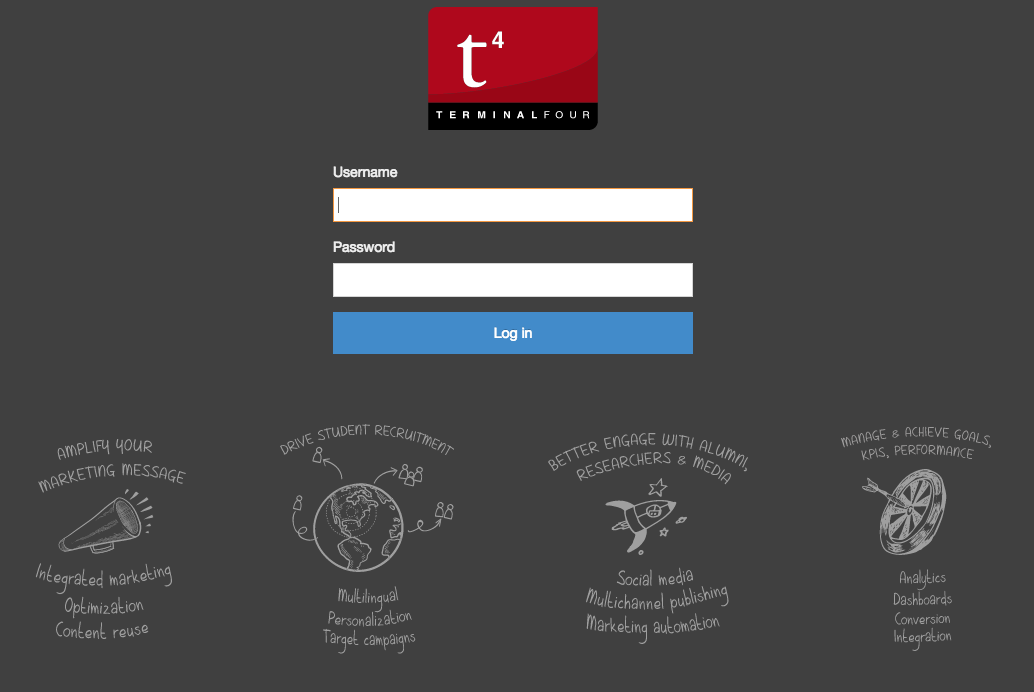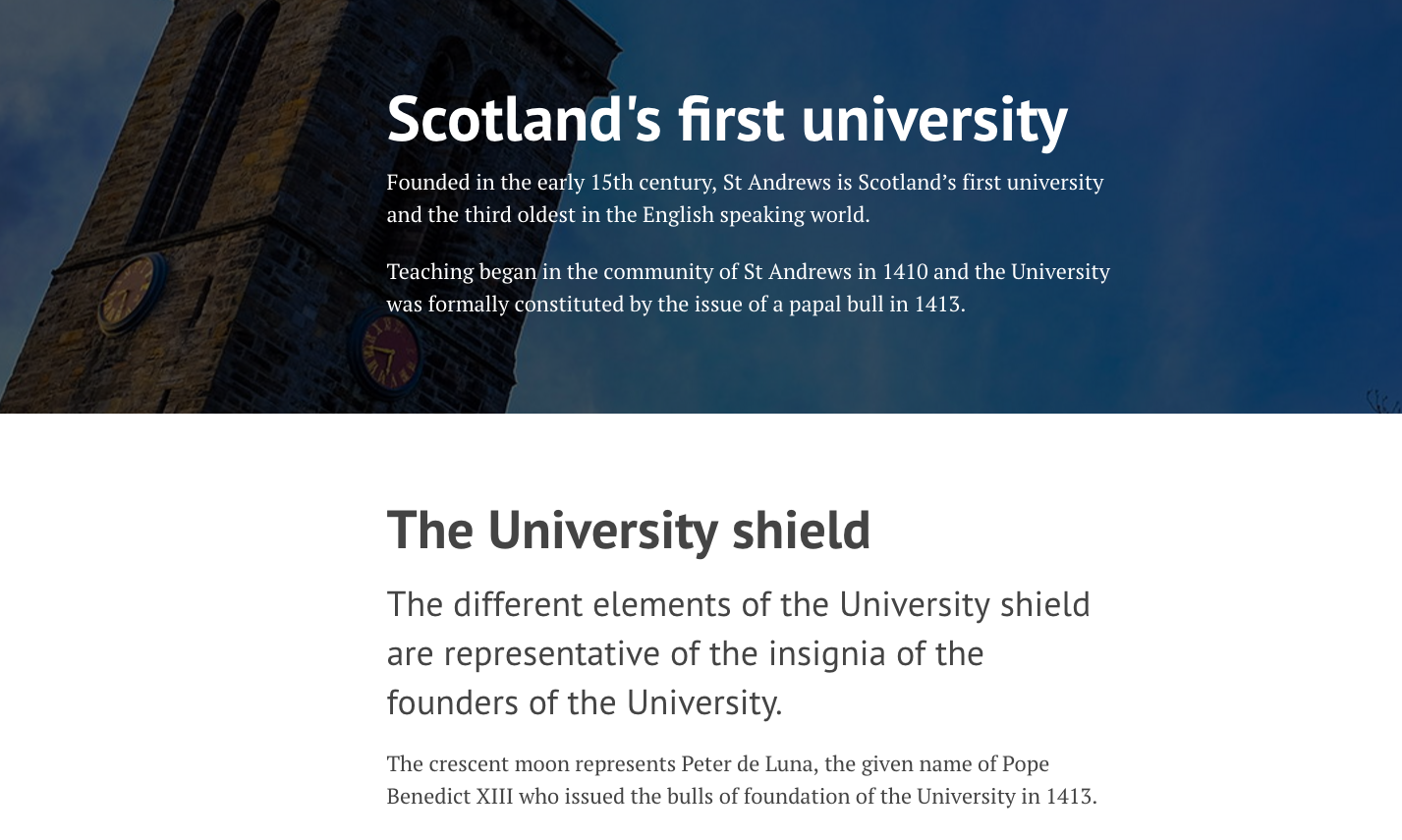Announcing the launch of T4v8
Soon, the digital communications team will launch a suite of webpages from the newest version of our content management system, T4. This is the beginning of the new digital style rolling out to all external facing content. In time, all content for people outside of the University will be located in T4v8, in the digital communications look and feel.
The rationale for moving to T4v8
The University of St Andrews first started using T4v5 to publish out web content in 2007, and TerminalFour – the company who built the software – have been updating it since then. However, earlier this year TerminalFour launched a new iteration of the software – T4v8. Because of the existence of the new version, TerminalFour are no longer adding new features to T4v7 – which means that if we want all of the new, exciting features in T4, we need to move to the newest version.
The digital communications team sees an additional value to moving to T4v8 – it gives us the opportunity to build some bits of the website from scratch. We’ve learnt a lot about user behaviour and website use since the University website was architected. We now have the opportunity to test the things we’ve learnt, by creating a new site which doesn’t have some of the issues and idiosyncrasies that the current site has. While we’re moving to T4v8, we’re also thinking of how T4v8 will integrate with other projects which are progressing across the University, such as the introduction of SharePoint as a potential intranet system.
Our approach so far
Just getting T4v8 installed was a big job. Even though we’d done it before, years ago, it was still a lot of trial and error to get it up and running. IT services and TerminalFour helped us get that all sorted.
And then we had the coveted blank slate, the new start, that we wished for. The key to building in T4 is reusability and we were happy to start with building only the parts of the website that are for external visitors. We were able to hugely reduce the number of content types, and page layouts, which means it’s much simpler to build the pages for content editors on the backend. There were instances of “disagreement” where we enthusiastically discussed how to best migrate a bit of content, or how a specific bit of content should look, but that makes for the best website we can make.
One of the big tasks for the content team was the audit of content which exists in the sections of the website that we were due to be moved. This involved ensuring that the content was still up-to-date, with no broken links and that we had a map of all pages in the following sections of the website:
- University homepage
- about
- community facilities
- business services
- graduation
- orientation
- digital standards
- website help.
Once we had audited and mapped the content, it was a case of migrating the pages from T4v7 to T4v8. With over 900 pages and hundreds of media library files to transfer, this was a large task that took the content team a number of weeks to complete.
“Oh bugs how I hate thee, how can I count the ways?” Well that might be a bit strong, but I hope it doesn’t sound so far like this was a completely bump-free transition to v8. Through rigorous bug hunting and fixing we’re confident that T4v8 will be more robust as it includes fixes to many bugs and a host of new features.
Once our bugs were ironed out, the content team put time in the diary to QA (quality assure) all of the content which had been migrated. This involved every member of the team carefully accessing each page on the test website alongside the current site to check that there are no inconsistencies between them, and that all bugs identified on T4v8 were no longer occurring. We aim to ensure that no one QAs a piece of work that they were responsible for, so at least two people have checked each webpage before it goes live.
Launch process
When we launch T4v8 we will still have the old v7 running, as we’ve only migrated over the external website to v8. But getting the two to play nicely is a little bit complex. T4 is a little different as far as CMSs go; it sits on its own server and publishes static website files to another server. The trouble will be getting both versions of T4 to cooperate with putting their webpages on the same server; it’s a little like making two children put their toys in a box without fighting. In addition to this we will still be running the external website from v7, so we need to make any changes in v7 and v8. We’d like to launch v8 as soon as possible so we can avoid doing that for too long.
Timeline
What do we need to get done to launch T4v8?
- Buy the licence (done)
- Copy the server which publishes the site from dev to production
- IT services does some tech related sorcery
- Final check
- Switch on!
- We aim to do the big switch before Christmas this year.
Impact
We have had a lot of questions from colleagues about what the launch of T4v8 will mean for them. We want to reassure all users that there will be neither a change to how the website works or to any processes or workflows in the short-term.
For users who are not staff at St Andrews, there should be no awareness that we have moved to T4v8; the homepage and almost all pages will look exactly the same. (The only page we have updated the design of is the facts and figures page, which has been brought into a style more like our long form stories.) Because of our work with IT Services, no one should notice that we are using two different versions of the CMS – they should just see the website, much as they do at the moment.
We also wish to state that staff members should not be concerned about the installation of T4v8 at this time. The sections of the University website which have been migrated are all sections which are currently only able to be edited by the digital communications team, and the process to update any of these sections remains the same. (Please email [email protected] if you’d like more details on how to request changes to these pages.) In time, we plan to move more of the external facing website to T4v8 – but we do not anticipate being ready to start on this migration until mid 2017. At that point, we will reach out to the content coordinators in Schools and Units, providing support during the migration phase and training in T4v8.
What next?
The next steps for the digital communications team is to complete the digital prospectus – the revamp of all information on the website for prospective students. This will involve taking our recently launched postgraduate taught webpages, and publishing them out of T4v8 using centrally-held data from SITS. We also plan to create a new course search tool which will be incorporate information about our undergraduate courses, also pulling data from SITS. This is our current focus and is likely to continue until at least spring 2017.

Alongside this, we are reaching out to computing officers in Schools to establish whether they have the ability to undertake training in T4v8 and the digital pattern library. If computing officers are able to work with us to develop patterns and content types, we’ll be able to start looking at redeveloping School websites a lot sooner.

